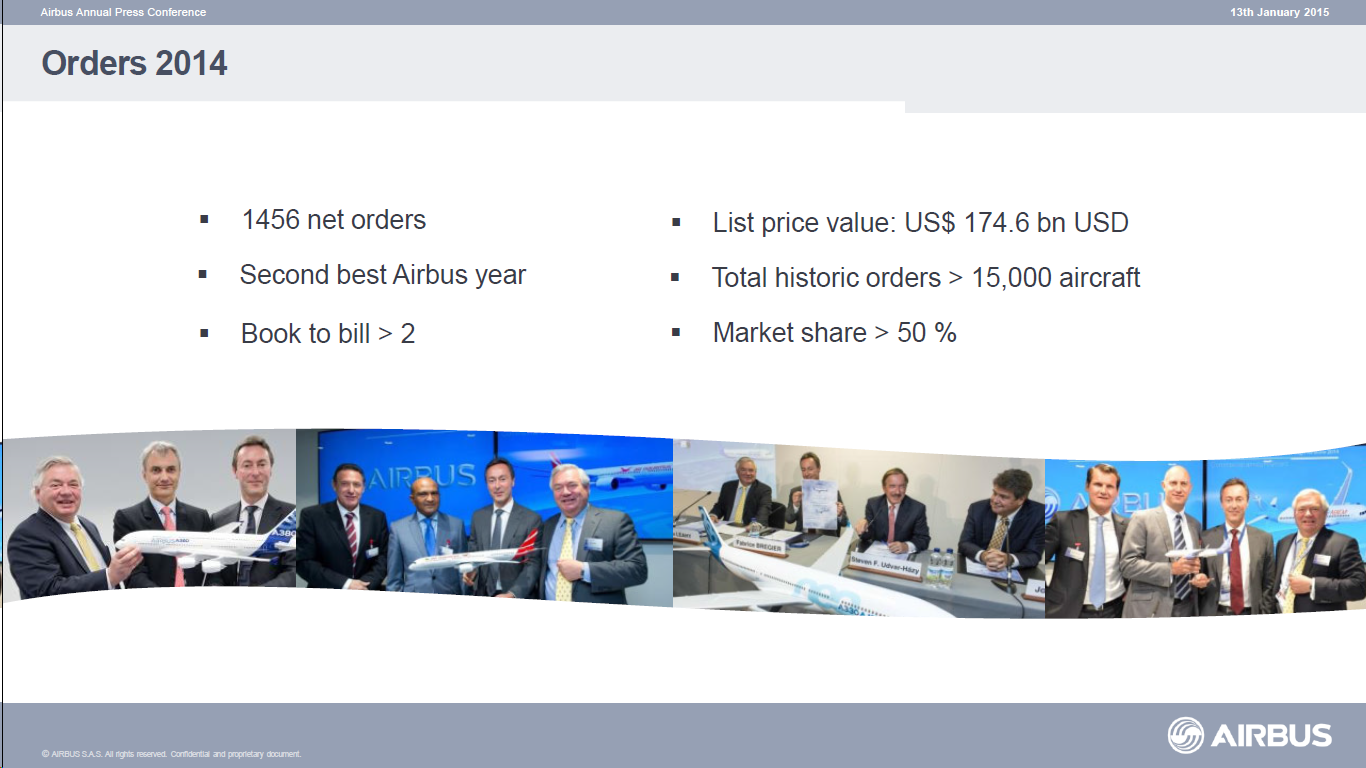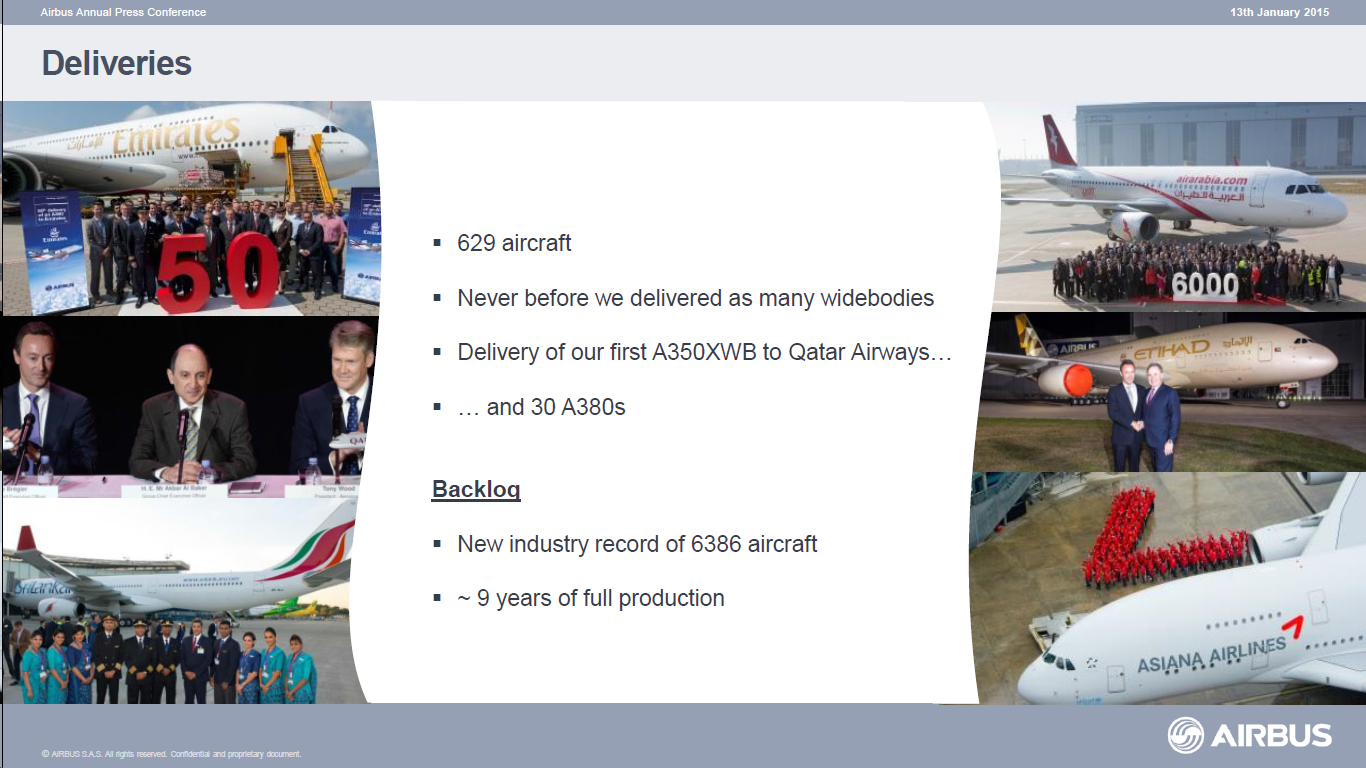Leeham News and Analysis
There's more to real news than a news release.
Airbus formally launches A321LR; we look behind the “LR” to see what’s there
15 Jan 2015: Airbus officially launched what to date has been called A321neoLR as the A321LR at their annual press conference Tuesday. The former A321neoLR name was formed by Leeham News on 21 Ocober 2014 when we could reveal the existence of a A321neo variant which Airbus had started to present to airlines at the time. The final name kept the LR attribute used in the article to distinguish the longer range variant from the standard A321neo.
started to present to airlines at the time. The final name kept the LR attribute used in the article to distinguish the longer range variant from the standard A321neo.
The A319 has used the LR designation but its use has been limited. The suffix is more commonly identified with Boeing, used as it is with the 777-200LR. Boeing has also commonly used the ER for extended range like 777-200ER, 737-900ER and 777-300ER.
Interview with John Leahy: A380 sales strategy going forward
Subscription required
Now open to all readers (Fe. 15, 2015)
By Bjorn Fehrm
Introduction
Jan 14 2015: In our deep analysis of the Airbus A380, we concluded that there is nothing wrong with the basic economics of the giant airplane. In fact, with today’s fuel prices, the aircraft’s Direct Operating Costs (DOC) are 20% below its alternatives in the market. Yet the aircraft is experiencing its worst sales drought since its launch, despite adding a leasing alternative during 2014 and efforts by Airbus.
its alternatives in the market. Yet the aircraft is experiencing its worst sales drought since its launch, despite adding a leasing alternative during 2014 and efforts by Airbus.
To understand why and what Airbus plans to do about it we arranged for an exclusive interview with Airbus Chief Operating Officer-Customers, John Leahy, at the sidelines of Airbus annual press conference.
Summary
- Our assessment of A380’s cost of operation
- Operating airlines experience with the A380
- Airbus sales strategy to date and changes going forward
Market potential for A321LR
Here’s how Airbus sees the market potential for the A321LR, going well beyond the 50-60 Boeing 757s flying the Atlantic and some limited operations on other routes.

Airbus believes the A321LR will expand the market considerably over the Boeing 757 long-range routes today. Source: Airbus.
Customer Quality counts as much as orders, says Boeing
Subscription Required
Introduction
Jan. 14, 2015: Customer quality counts as much as the raw number of orders, a top Boeing official said yesterday during a bit of counter-programming on the day Airbus held its annual press conference recapping the previous year’s orders and deliveries.
In a tele-press conference, John Wojick, Boeing SVP of Global Sales & Marketing, said, “It’s not just orders, it’s also about the quality. We work very hard to do business that will actually get to deliveries. We have a much stronger history of orders-to-deliveries than our competitor.”
Summary
- Wojick has a point: Boeing’s customer quality orders historically have been better than Airbus; but
- This is changing. Our Storm Warning Flag assessment shows an improved Airbus customer quality base among the top orders.
- Both companies overbook in anticipation of cancellations and deferrals; Airbus is more aggressive in this practice.
- Airbus had three times the cancellations in 2014 as Boeing.
Odds and Ends: More from Airbus annual press conference; IAM focuses on wages
Jan. 13, 2015: More from Airbus: Airbus held its annual press conference today in Toulouse, reporting its full year 2014 orders and deliveries results. Our Bjorn Fehrm was there and filed a report from the event. He will have more this week. Here are some stories from other media.
Reuters: Airbus to juggle production, defense A380. Airbus says it will likely take A320 production about 50/mo. We reported months ago the supply chain has been notified to prepare for rate 54 in 2018. Airbus also said it will bring A330ceo production down after 2015. We predict 5-6. Decisions are to be made in the coming months.
Bloomberg: Airbus to add 20 passengers to A350-1000.
Aviation Week: Airbus formally launches the A321neoLR. You read this plan here first last October.
Seattle Times: Boeing is No. 1 by some metrics. Dominic Gates takes his usual thorough look at the bragging rights of Airbus and Boeing.
IAM on wages: Boeing’s touch-labor union, the IAM 751, says a Washington State study about aerospace jobs shows 58% of non-Boeing aerospace jobs in the state are paying less than $15 per hour.
Boeing sees little impact from fuel on orders
Jan. 13, 2015: Boeing sees little impact on orders from the falling fuel prices.
In a tele-press conference this morning, Randy Tinseth, vice president of marketing, said recent history shows that even as fuel prices went down, the backlog of orders went up.
Oil is currently hovering around $46/bbl. The last time it was this low was 2008, after the global financial collapse. It took 2 1/2 years for oil prices to recover to around $100/bbl.
Airbus reveals record orders at annual press conference
By Bjorn Fehrm
Toulouse 13 Jan 2015: Airbus today held their annual press conference where they among other things revealed their final numbers for orders and deliveries. The press conference was hosted by Airbus CEO Fabrice Bregier accompanied by COO Customers John Leahy, new COO Tom Williams and new Head of Programs Didier Evrard.
Airbus in 2014
Bregier started with pointing out that 2014 was a very eventful year for Airbus. Airbus did their customary end of year sprint and passed Boeing for net orders with 24 aircraft netting 1456 commands, Figure 1.
On the delivery side Boeing is ahead with 723 deliveries versus Airbus 629, Figure 2.
Further Airbus certified the A350 and delivered the first aircraft to its launch customer, Qatar Airways. It also launched the A330neo and got 120 orders during the year. Finally they flew the A320neo first prototype.
A380neo decision likely this year, triggering the next widebody engine project
Subscription required
By Bjorn Fehrm
Introduction
Jan. 12, 2015: One of the subjects which is sure to come up on Airbus annual press conference on Tuesday the 13th in Toulouse will be when and how Airbus will re-engine the A380.
Airbus Commercial CEO Fabrice Bregier vowed during the Airbus Group Global Investors Day last month that an A380neo is coming.
There is much speculation around this subject as the business case of re-engineering an aircraft that is selling at such low numbers is difficult to get to close. The business case is difficult to make work for Airbus  (such a project will cost in the order of $2 billion) but it will be equally hard for the engine manufacturers to offer engines that have enough efficiency gain to make the overall project feasible from an efficiency improvement perspective.
(such a project will cost in the order of $2 billion) but it will be equally hard for the engine manufacturers to offer engines that have enough efficiency gain to make the overall project feasible from an efficiency improvement perspective.
Summary
- A380 Classic equals Boeing 777-300ER seat fuel costs.
- Boeing 777-9 beats A380 on CASM, an A380neo regains the advantage.
- Engine makers face hard choices to retain dominance or to broaden market penetration.
AirAsia 8501: two weeks later, still looking for the voice recorder
Jan. 11, 2015: It’s now been two weeks and two days (local time) since AirAsia Flight 8501 crashed into the Java Sea. It took nearly two weeks just to locate the tail section of the airplane, which was raised. The flight data recorder was recovered Jan. 12 local time but the cockpit voice recorder is still missing.
Greg Feith, a former crash investigator for the US National Transportation Safety Board, wrote Sunday on his Facebook page, “ADS-B data was used to narrow the search area for the main wreckage. Info from both black boxes will finally provide a factual foundation that the airplane likely ended up in a high speed descent, probably a spiral descent, and impacted the water in an out-of-control situation and not an attempted emergency landing. With the main wreckage scattered, the airplane likely broke-up and skipped across the surface. We should know soon as the info is developed and provided by the NTSC.”



